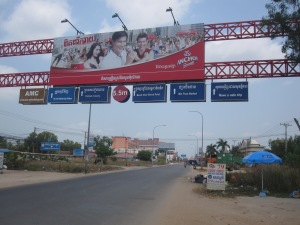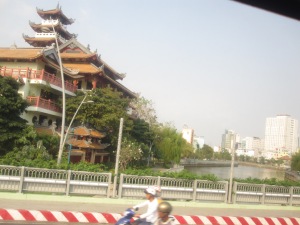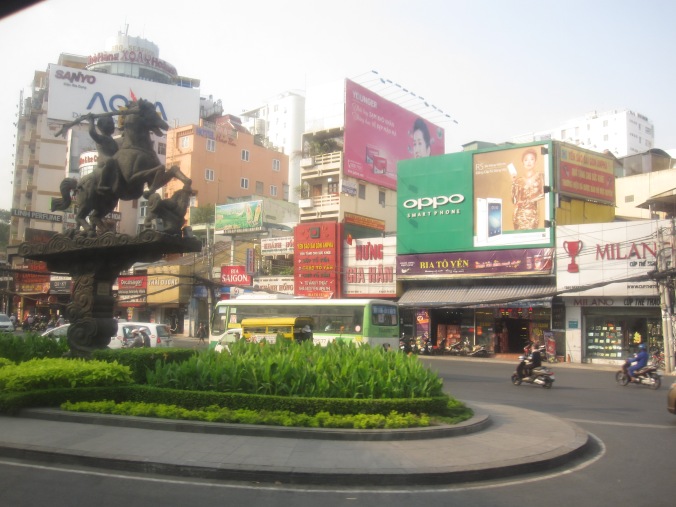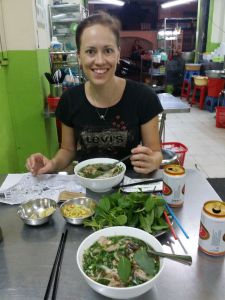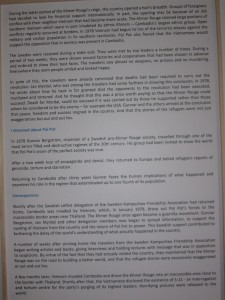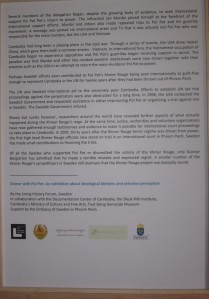Vi mötte upp vår tuk tuk-förare kl 9 på morgonen (måndag den 16:e februari) för färd mot dödens fält i Choeung Ek som ligger ca 15 km söder om Phnom Penh. Färden dit blev en upptäcktsfärd av de södra delarna av Phnom Penh, då vi blev tvungna att ta många små bakgator för att komma förbi vägarbeten och hinder på vägen.
Inträdet till dödens fält var 6 dollar för utlänningar och då fick man en audioguide där vi fick höra den hemska historien om hur fångar från fängelset S-21 togs till dödens fält för att avrättas. Fångarna från S-21 var intellektuella, politiska motståndare, misstänkta CIA/KGB-agenter, människor som hade någon någon form av högre utbildning och ej hade valkar på händerna efter hårt fysiskt arbete, samt deras partners och barn. Pol Pots filosofi var att gräset måste dras upp med rötterna, annars kanske de växer upp och kräver hämnd.

“The killing tree” där de minsta barnen dödades genom att deras huvuden svingades mot trädet. The killing tree, where guards murdered the smallest children by swinging their heads against the tree.
De flesta som fördes dit dog på grund av slag mot huvudet med machete, hammare, bambupinnar, spadar m.m och de minsta barnen dödades genom att någon vakt svingade dem hårt mot “the killing tree” innan de kastades ned i en massgrav. Eventuella skrik dränktes av ljudet från högtalare som spelade upp kommunistisk propaganda och ljudet av dieselmotorer.
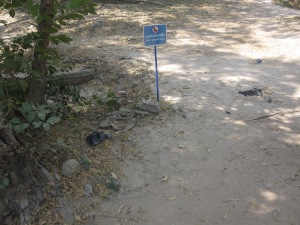
Trampa ej på ben! Don’t step on bone!
Fångarna från S-21 fördes dit på kvällen då det var mörkt, där de tio unga killarna som jobbade på lägret redan hade grävt upp 5 meter djupa gravar för att rymma kvällens last med fångar. De som inte dog av slaget mot huvudet, dog av DDT som hälldes över kropparna vilket syftade till att maskera doften av förruttnade kroppar. Gravarna fylldes igen innan det blev morgon för att inte de lokala bönderna skulle bli misstänksamma. När vi gick omkring på området så såg vi flera skelettdelar på marken som kommer upp till ytan av markens rörelser och regn. Dessa samlas in en gång i månaden av parkvakterna och läggs till skelettsamlingen på området. Man uppskattar att ungefär 17 000 människor ligger begravda vid Choeung Ek och cirka 9 000 av dem grävdes upp vid utgrävningarna 1980. 1988 restes minnesmärket och begravningsplatsen “Stupa” där delarna från de uppgrävda kropparna förvaras.
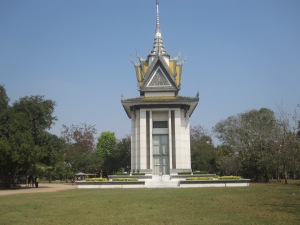
Stupan som byggts till minne av offren och den har både element av hinduism och buddishm. I de nedersta våningarna förvaras skallarna av offren (se nästa bild). The Stupa is built in memory of the victims and the building has elements of both Hinduism and Buddishm. In the lower floors of the monument the victims skulls are kept (see next picture).
Idag har man hittat 198 sådana här platser med totalt 20 000 massgravar runt om i Kambodja där en stor del av offren för kommunisternas härjningar ligger begravda.
We met up with our tuk tuk driver at 9 in the morning (Monday, 16 February) for our journey to the killing fields of Choeung Ek, which is located about 15 km south of Phnom Penh. We had to take many small back streets to get past all the road works and obstacles along the way, so we had a great opportunity to see the south areas of Phnom Penh
Entrance fee was $ 6 for foreigners and an audioguide was included in the entrance fee. We heard the gruesome stories about the prisoners from S-21 (prison in Phnom Penh) that were taken to the killing fields for execution. The prisoners from S-21 was intellectuals, political opponents, suspected CIA/ KGB agents, people who had some form of higher education and could not show up calluses on their hands caused by hard physical work, as well as their partners and children. Pol Pot’s philosophy was that the grass must be pulled up by the roots, otherwise they will grow up and seek revenge.

Skallarna som förvaras längst ned i stupan. The skulls on the lowest floor of the stupa!
Most died from blows to the head with machetes, hammers, bamboo sticks, shovels etc. and the smallest children were killed by guards swinging them hard against “The Killing Tree” before they were thrown into a mass grave. Any loud screams were drowned by the sound of the speakers that played communist propaganda and the sounds of diesel engines.
The prisoners from S-21 came to Choeung Ek in the evening when it was dark and where met by ten young men, working at the camp, who already had dug up five meter deep graves to accommodate the evening’s load of prisoners. Those who did not die by the blows to the the head, died of DDT which was poured over the bodies in order to mask the smell of decaying bodies. The graves were filled again before the morning, so the local farmers would not be suspicious. As we walked around the area, we saw several skeletal remains on the ground coming up to the surface because of the soil movements and rain. The remains are collected once a month by the rangers and added to the skeleton collection in the field. It is estimated that approximately 17,000 people are buried at Choeung Ek and about 9000 of them were unearthed during the excavation of 1980. In 1988, the monument and cemetery “Stupa” with parts from the exhumed bodies was erected.
Today they have found 198 locations with a total of 20,000 mass graves across Cambodia were victims during the communist ravages are still buried.

Utgrävda massgravar vid Choeung Ek. Excavated mass graves in Cheoung Ek!

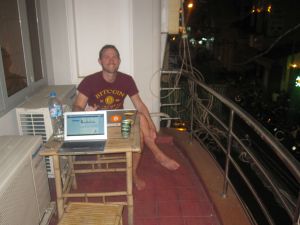
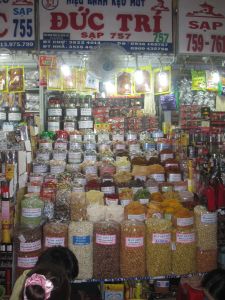
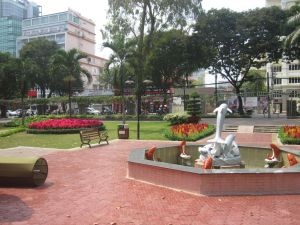
 Vi fick ta del av nästan 20 år av våld, död, terror och förtvivlan som sträcker sig ända till nutid här i Vietnam. Konflikten fick sin början 1955 strax efter att Frankrike besegrades militärt och deras imperialistiska erövringskrig i indokina krossades med resultat i att Vietnam delades i kommunistiska Nordvietnam stödda av Sovjetunionen och Kina, samt Sydvietnam stödda av USA. Nordvietnam ledd av kommunistledaren Ho Chi Minh ville befria hela Vietnam från imperialisterna. Det var planerat för demokratiska val i Vietnam 1956 med stöd av det internationella samfundet men Sydvietnams USA-stödda ledare Ngo Dinh Diem vägrade demokratiska val då opinionen var för kommunistledaren Ho Chi Minh (demokrati tillåts endast då det passar!).
Vi fick ta del av nästan 20 år av våld, död, terror och förtvivlan som sträcker sig ända till nutid här i Vietnam. Konflikten fick sin början 1955 strax efter att Frankrike besegrades militärt och deras imperialistiska erövringskrig i indokina krossades med resultat i att Vietnam delades i kommunistiska Nordvietnam stödda av Sovjetunionen och Kina, samt Sydvietnam stödda av USA. Nordvietnam ledd av kommunistledaren Ho Chi Minh ville befria hela Vietnam från imperialisterna. Det var planerat för demokratiska val i Vietnam 1956 med stöd av det internationella samfundet men Sydvietnams USA-stödda ledare Ngo Dinh Diem vägrade demokratiska val då opinionen var för kommunistledaren Ho Chi Minh (demokrati tillåts endast då det passar!).
 bombningar av Nordvietnam.
bombningar av Nordvietnam.
 The conflict was started in 1955 shortly after France was defeated militarily and their imperialist wars of conquest in Indochina was crushed with the result that Vietnam was divided into communist North Vietnam, supported by the Soviet Union and China, and South Vietnam, supported by the United States. North Vietnam led by communist leader Ho Chi Minh wanted to liberate all of Vietnam from the imperialists. It was planned for democratic elections in Vietnam in 1956 with the support of the international community, but South Vietnam’s US-backed leader Ngo Dinh Diem refused democratic elections when public opinion was for communist leader Ho Chi Minh (democracy is allowed only when it fits!).
The conflict was started in 1955 shortly after France was defeated militarily and their imperialist wars of conquest in Indochina was crushed with the result that Vietnam was divided into communist North Vietnam, supported by the Soviet Union and China, and South Vietnam, supported by the United States. North Vietnam led by communist leader Ho Chi Minh wanted to liberate all of Vietnam from the imperialists. It was planned for democratic elections in Vietnam in 1956 with the support of the international community, but South Vietnam’s US-backed leader Ngo Dinh Diem refused democratic elections when public opinion was for communist leader Ho Chi Minh (democracy is allowed only when it fits!).

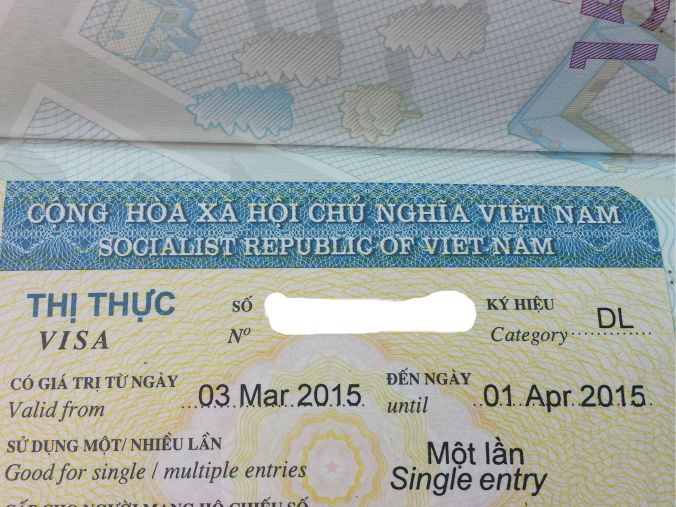 . Det hela gick smidigt och vi anlände till Ho Chi Minh kl 16 på eftermiddagen. Vi hittade ett jättebra blogginlägg om själva resan och vi länkar till den
. Det hela gick smidigt och vi anlände till Ho Chi Minh kl 16 på eftermiddagen. Vi hittade ett jättebra blogginlägg om själva resan och vi länkar till den 